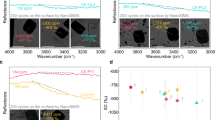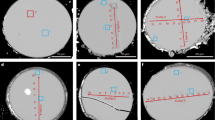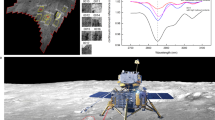Abstract
Analyses of samples from the Apollo missions suggest that the Moon formed devoid of native water. However, recent observations by Cassini, Deep Impact, Lunar Prospector and Chandrayaan-1 indicate the existence of an active water cycle on the Moon. Here we report observations of this water cycle, specifically detections of near-surface water released into the lunar exosphere by the Neutral Mass Spectrometer on the Lunar Atmosphere and Dust Environment Explorer. The timing of 29 water releases is associated with the Moon encountering known meteoroid streams. The intensities of these releases reflect the convoluted effects of the flux, velocity and impact location of the parent streams. We propose that four additional detected water releases represent the signature of previously undiscovered meteoroid streams. We show that water release from meteoroid impacts is indicative of a lunar surface that has a desiccated soil layer of several centimetres on top of uniformly hydrated soil. We infer that the Moon is currently in the process of losing water that was either delivered long ago or present at its formation.
This is a preview of subscription content, access via your institution
Access options
Access Nature and 54 other Nature Portfolio journals
Get Nature+, our best-value online-access subscription
$29.99 / 30 days
cancel any time
Subscribe to this journal
Receive 12 print issues and online access
$259.00 per year
only $21.58 per issue
Buy this article
- Purchase on Springer Link
- Instant access to full article PDF
Prices may be subject to local taxes which are calculated during checkout



Similar content being viewed by others
Data availability
The NMS data supporting this Article are publicly available from the Planetary Data System (http://pds-atmospheres.nmsu.edu/data_and_services/atmospheres_data/LADEE/nms.html).
Code availability
The Matlab scripts used for the analyses and modelling described in this study can be obtained from the corresponding author on reasonable request.
References
Taylor, S. R. Lunar Science: A Post-Apollo View (Pergamon, 1975).
Papike, J. J., Taylor L. & Simon, S. in The Lunar Source Book (eds Heiken, G.H. et al.) 121–182 (Cambridge Univ. Press, 1991).
Lucey, P. et al. Understanding the lunar surface and space–Moon interactions. Rev. Miner. Geochem. 60, 83–219 (2006).
Shearer, C. K. et al. Thermal and magmatic evolution of the Moon. Rev. Miner. Geochem. 60, 365–518 (2006).
Clark, R. N. Detection of adsorbed water and hydroxyl on the Moon. Science 326, 562–564 (2009).
Sunshine, J. M. et al. Temporal and spatial variability of lunar hydration as observed by the Deep Impact spacecraft. Science 326, 565–568 (2009).
Pieters, C. M. et al. Character and spatial distribution of OH/H2O on the surface of the Moon seen by M3 on Chandrayaan-1. Science 326, 568–572 (2009).
Feldman, W. C. et al. Fluxes of fast and epithermal neutrons from lunar prospector: evidence for water ice at the lunar poles. Science 218, 1496–1500 (1998).
Mitrofanov, I. G. et al. Mapping of the lunar south pole using the LRO neutron detector experiment LEND. Science 330, 483–486 (2010).
Colaprete, A. et al. Detection of water in the LCROSS ejecta plume. Science 330, 463–468 (2010).
Watson, K., Murray, B. & Brown, H. On the possible presence of ice on the Moon. J. Geophys. Res. 66, 1598–1600 (1961).
Arnold, J. R. Ice in the lunar polar regions. J. Geophys. Res. 84, 5659–5668 (1979).
Housley, R. M., Cirlin, E. H. & Grant, R. W. Characterization of fines from the Apollo 16 site. Geochim. Cosmochim. Acta 3, 2623–2642 (1974).
Urey, H. C. The Planets, Their Origin and Development (Yale Univ. Press, 1952).
Crider, D. H. & Vondrak, R. R. Space weathering effects on lunar cold trap deposits. J. Geophys. Res. 108, 5078 (2003).
Hurley, D. H. & Benna, M. Simulations of lunar exospheric water events from meteoroid impacts. Planet. Space Sci. 162, 148–156 (2017).
Prem, P., Artemieva, N. A., Goldstein, D. B., Varghese, P. L. & Trafton, M. Transport of water in a transient impact-generated lunar atmosphere. Icarus 255, 148–158 (2015).
Lawrence, D. J. et al. Bulk hydrogen abundances in the lunar highlands: measurements from orbital neutron data. Icarus 255, 127–135 (2015).
Li, S. & Milliken, R. E. Water on the surface of the Moon as seen by the Moon Mineralogy Mapper: distribution, abundance, and origins. Sci. Adv. 3, e1701471 (2017).
Elphic, R. C. et al. The Lunar Atmosphere and Dust Environment Explorer mission. Space Sci. Rev. 185, 3–25 (2014).
Mahaffy, P. M. et al. The Neutral Mass Spectrometer on the Lunar Atmosphere and Dust Environment Explorer mission. Space Sci. Rev. 185, 27–61 (2014).
Benna, M., Mahaffy, P. R., Halekas, J. S., Elphic, R. C. & Delory, G. T. Variability of helium, neon, and argon in the lunar exosphere as observed by the LADEE. Geophys. Res. Lett. 42, 3723–3729 (2015).
Hodges, R. R. Jr Methane in the lunar exosphere: implications for solar wind carbon escape. Geophys. Res. Lett. 43, 6742–6748 (2016).
Halekas, J. S. et al. Detections of lunar exospheric ions by the LADEE neutral mass spectrometer. Geophys. Res. Lett. 42, 5162–5169 (2015).
Jopeka, T. J. & Kaňuchová, Z. IAU Meteor Data Center—the shower database: a status report. Planet. Space Sci. 143, 3–6 (2017).
Horányi, M. et al. A permanent, asymmetric dust cloud around the Moon. Nature 522, 324–326 (2015).
Szalay, J. R. & Horányi, M. Detecting meteoroid streams with an in-situ dust detector above an airless body. Icarus 275, 221–231 (2016).
International Meteor Organization (accessed 18 January 2018); http://www.imo.net/
Vasavada, A. R. et al. Lunar equatorial surface temperatures and regolith properties from the Diviner Lunar Radiometer Experiment. J. Geophys. Res. 117, E00H18 (2012).
Hayne, P. O. et al. Global regolith thermophysical properties of the Moon from the Diviner Lunar Radiometer Experiment. J. Geophys. Res. 122, 2371–2400 (2017).
Schorghofer, N. & Aharonson, O. The lunar thermal ice pump. Astrophys. J. 788, 169 (2014).
Housley, R. M., Grant, R. W. & Paton, N. E. Origin and characteristics of excess Fe metal in lunar glass welded aggregates. Geochim. Cosmochim. Acta 3, 2737–2749 (1973).
Mazarico, E. et al. Illumination conditions of the lunar polar regions using LOLA topography. Icarus 211, 1066–1081 (2011).
Grün, E., Zook, H. A., Fetchtig, H. & Giese, R. H. Collisional balance of the meteoritic complex. Icarus 62, 244–272 (1985).
Halliday, I., Griffin, A. A. & Blackwell, A. T. Detailed data for 259 fireballs from the Canadian camera network and inferences concerning the influx of large meteoroids. Meteorit. Planet. Sci 31, 185–217 (1996).
Brown, P., Spalding, R. E., ReVelle, D. O., Tagliaferri, E. & Wordenk, S. P. The flux of small near-earth objects colliding with the Earth. Nature 420, 294–296 (2002).
Steyaert, C. Calculating the solar longitude 2000.0. WGN 19, 31–34 (1991).
Melosh, H. J. Impact Cratering: A Geologic Process 60–65 (Oxford Univ. Press, 1989).
Molau, S. et al. Results of the IMO Video Meteor Network—December 2015. WGN 44, 51–56 (2015).
Jenniskens, P. Meteor stream activity. Astron. Astrophys. 287, 990–1013 (1994).
Holsapple, K. A. The scaling of impact processes in planetary science. Annu. Rev. Earth Planet. Sci. 21, 333–373 (1993).
Hanner, M. & Zolensky, M. in Astromineralogy (ed. Henning, T.) 203–232 (Springer, 2010).
Cintala, M. J. Impact-induced thermal effects in the lunar and mercurian regoliths. J. Geophys. Res. 97, 947–973 (1992).
Lange, M. A., Lambert, P. & Ahrens, T. J. Shock effects on hydrous minerals and implications for carbonaceous meteorites. Geochim. Cosmochim. Acta 48, 1715–1726 (1985).
Poston, M. J. et al. Temperature programmed desorption studies of water interactions with Apollo lunar samples 12001 and 72501. Icarus 255, 24–29 (2015).
Slyuta, E. N. et al. Application of thermodesorption mass spectrometry for studying proton water formation in the lunar regolith. Geochem. Int. 55, 27–37 (2017).
Acknowledgements
The LADEE/NMS investigation was supported by NASA. Tests and calibrations were completed at the Planetary Environment Laboratory of NASA’s Goddard Space Flight Center. We thank R. R. Vondrak, W. M. Farrell, R. M. Killen and T. H. Morgan for insightful discussions and comments. We also thank E. Raaen for his calibration support, E. Zubritsky for editing and J. Friedlander for graphics assistance.
Author information
Authors and Affiliations
Contributions
M.B. directed the data analysis and was primarily responsible for writing the article. D.M.H. developed the exosphere model and helped analyse and interpret the NMS data. T.J.S. conducted the correlation analysis between meteoroid streams and the NMS observations. P.R.M. is the principal investigator of the instrument and contributed to instrument calibration and data analysis. R.C.E. is the LADEE project scientist, developed the LADEE observation plans for the NMS, coordinated data acquisition with other LADEE instruments and contributed to data analysis.
Corresponding author
Ethics declarations
Competing interests
The authors declare no competing interests.
Additional information
Publisher’s note: Springer Nature remains neutral with regard to jurisdictional claims in published maps and institutional affiliations.
Supplementary information
Supplementary Information
Supplementary Materials 1–6, Supplementary Figs. 1–17 and Supplementary Tables 1 and 2.
Rights and permissions
About this article
Cite this article
Benna, M., Hurley, D.M., Stubbs, T.J. et al. Lunar soil hydration constrained by exospheric water liberated by meteoroid impacts. Nat. Geosci. 12, 333–338 (2019). https://doi.org/10.1038/s41561-019-0345-3
Received:
Accepted:
Published:
Issue Date:
DOI: https://doi.org/10.1038/s41561-019-0345-3
This article is cited by
-
Future Directions for the Investigation of Surface-Bounded Exospheres in the Inner Solar System
Space Science Reviews (2023)
-
A solar wind-derived water reservoir on the Moon hosted by impact glass beads
Nature Geoscience (2023)
-
Evidence of water on the lunar surface from Chang’E-5 in-situ spectra and returned samples
Nature Communications (2022)
-
Exogenic origin for the volatiles sampled by the Lunar CRater Observation and Sensing Satellite impact
Nature Communications (2022)
-
Solar System Science with the Orbiting Astronomical Satellite Investigating Stellar Systems (OASIS) Observatory
Space Science Reviews (2022)



